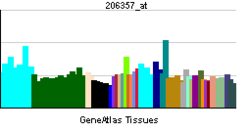- OPA3
-
Optic atrophy 3 (autosomal recessive, with chorea and spastic paraplegia) Identifiers Symbols OPA3; FLJ22187; FLJ25932; MGA3; MGC75494 External IDs OMIM: 606580 MGI: 2686271 HomoloGene: 57022 GeneCards: OPA3 Gene Gene Ontology Cellular component • mitochondrion
• mitochondrionBiological process • visual perception
• response to stimulusSources: Amigo / QuickGO RNA expression pattern 
More reference expression data Orthologs Species Human Mouse Entrez 80207 403187 Ensembl ENSG00000125741 ENSMUSG00000052214 UniProt Q9H6K4 n/a RefSeq (mRNA) NM_001017989.2 NM_207525.3 RefSeq (protein) NP_001017989.2 NP_997408.2 Location (UCSC) Chr 19:
46.03 – 46.11 MbChr 7:
19.81 – 19.84 MbPubMed search [1] [2] Optic atrophy 3 protein is a protein that in humans is encoded by the OPA3 gene.[1][2][3]
Contents
See also
References
- ^ Nystuen A, Costeff H, Elpeleg ON, Apter N, Bonne-Tamir B, Mohrenweiser H, Haider N, Stone EM, Sheffield VC (Jul 1997). "Iraqi-Jewish kindreds with optic atrophy plus (3-methylglutaconic aciduria type 3) demonstrate linkage disequilibrium with the CTG repeat in the 3' untranslated region of the myotonic dystrophy protein kinase gene". Hum Mol Genet 6 (4): 563–9. doi:10.1093/hmg/6.4.563. PMID 9097959.
- ^ Anikster Y, Kleta R, Shaag A, Gahl WA, Elpeleg O (Nov 2001). "Type III 3-Methylglutaconic Aciduria (Optic Atrophy Plus Syndrome, or Costeff Optic Atrophy Syndrome): Identification of the OPA3 Gene and Its Founder Mutation in Iraqi Jews". Am J Hum Genet 69 (6): 1218–24. doi:10.1086/324651. PMC 1235533. PMID 11668429. http://www.pubmedcentral.nih.gov/articlerender.fcgi?tool=pmcentrez&artid=1235533.
- ^ "Entrez Gene: OPA3 optic atrophy 3 (autosomal recessive, with chorea and spastic paraplegia)". http://www.ncbi.nlm.nih.gov/sites/entrez?Db=gene&Cmd=ShowDetailView&TermToSearch=80207.
Further reading
- Bonaldo MF, Lennon G, Soares MB (1997). "Normalization and subtraction: two approaches to facilitate gene discovery". Genome Res. 6 (9): 791–806. doi:10.1101/gr.6.9.791. PMID 8889548.
- Hartley JL, Temple GF, Brasch MA (2001). "DNA Cloning Using In Vitro Site-Specific Recombination". Genome Res. 10 (11): 1788–95. doi:10.1101/gr.143000. PMC 310948. PMID 11076863. http://www.pubmedcentral.nih.gov/articlerender.fcgi?tool=pmcentrez&artid=310948.
- Kleta R, Skovby F, Christensen E, et al. (2003). "3-Methylglutaconic aciduria type III in a non-Iraqi-Jewish kindred: clinical and molecular findings". Mol. Genet. Metab. 76 (3): 201–6. doi:10.1016/S1096-7192(02)00047-1. PMID 12126933.
- Strausberg RL, Feingold EA, Grouse LH, et al. (2003). "Generation and initial analysis of more than 15,000 full-length human and mouse cDNA sequences". Proc. Natl. Acad. Sci. U.S.A. 99 (26): 16899–903. doi:10.1073/pnas.242603899. PMC 139241. PMID 12477932. http://www.pubmedcentral.nih.gov/articlerender.fcgi?tool=pmcentrez&artid=139241.
- GARCIN R, RAVERDY P, DELTHIL S, et al. (1998). "[On a heredo-familial disease combining cataract, optic atrophy, extrapyramidal symptoms and certain defects of Friedreich's disease. (Its nosological position in relation to the Behr's syndrome, the Marinesco-Sjogren syndrome and Friedreich's disease with ocular symptoms.]". Rev. Neurol. (Paris) 104: 373–9. PMID 13703570.
- Ota T, Suzuki Y, Nishikawa T, et al. (2004). "Complete sequencing and characterization of 21,243 full-length human cDNAs". Nat. Genet. 36 (1): 40–5. doi:10.1038/ng1285. PMID 14702039.
- Reynier P, Amati-Bonneau P, Verny C, et al. (2005). "OPA3 gene mutations responsible for autosomal dominant optic atrophy and cataract". J. Med. Genet. 41 (9): e110. doi:10.1136/jmg.2003.016576. PMC 1735897. PMID 15342707. http://www.pubmedcentral.nih.gov/articlerender.fcgi?tool=pmcentrez&artid=1735897.
- Gerhard DS, Wagner L, Feingold EA, et al. (2004). "The Status, Quality, and Expansion of the NIH Full-Length cDNA Project: The Mammalian Gene Collection (MGC)". Genome Res. 14 (10B): 2121–7. doi:10.1101/gr.2596504. PMC 528928. PMID 15489334. http://www.pubmedcentral.nih.gov/articlerender.fcgi?tool=pmcentrez&artid=528928.
- Wiemann S, Arlt D, Huber W, et al. (2004). "From ORFeome to Biology: A Functional Genomics Pipeline". Genome Res. 14 (10B): 2136–44. doi:10.1101/gr.2576704. PMC 528930. PMID 15489336. http://www.pubmedcentral.nih.gov/articlerender.fcgi?tool=pmcentrez&artid=528930.
- Kimura K, Wakamatsu A, Suzuki Y, et al. (2006). "Diversification of transcriptional modulation: Large-scale identification and characterization of putative alternative promoters of human genes". Genome Res. 16 (1): 55–65. doi:10.1101/gr.4039406. PMC 1356129. PMID 16344560. http://www.pubmedcentral.nih.gov/articlerender.fcgi?tool=pmcentrez&artid=1356129.
- Mehrle A, Rosenfelder H, Schupp I, et al. (2006). "The LIFEdb database in 2006". Nucleic Acids Res. 34 (Database issue): D415–8. doi:10.1093/nar/gkj139. PMC 1347501. PMID 16381901. http://www.pubmedcentral.nih.gov/articlerender.fcgi?tool=pmcentrez&artid=1347501.
- Fink N, Mouallem M (2006). "[Costeff syndrome: a syndrome that was described in Israel and the responsible gene discovered by an Israeli doctor]". Harefuah 145 (6): 402–3, 472. PMID 16838891.
External Links
Categories:- Human proteins
- Chromosome 19 gene stubs
Wikimedia Foundation. 2010.
